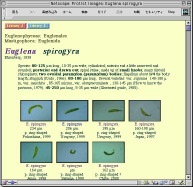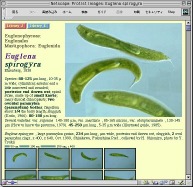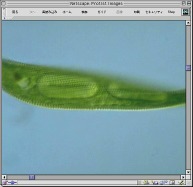Basic features of Protist image database
 Protist image database was originally aimed to collect images (photo copies) and other research resources which have been kept and unused by us and other researchers (mostly protozoologists). Thus, our database firstly became consisting of images of a limited number of species which are used in laboratories, such as Paramecium or Amoeba.
Protist image database was originally aimed to collect images (photo copies) and other research resources which have been kept and unused by us and other researchers (mostly protozoologists). Thus, our database firstly became consisting of images of a limited number of species which are used in laboratories, such as Paramecium or Amoeba.
 However, after publicizing the database we found most users are not protistologists but researchers in other fields or non-researchers, i.e., school teachers or people working at Water Service or at companies concerning environmental assessment, and so on, and they all want to know basic taxonomy of protists.
However, after publicizing the database we found most users are not protistologists but researchers in other fields or non-researchers, i.e., school teachers or people working at Water Service or at companies concerning environmental assessment, and so on, and they all want to know basic taxonomy of protists.
 Therefore, we have shifted the main purpose of our database from collecting mere research resources to compiling resources on protist taxonomy (i.e., images of many protists collected from field and their relevant descriptions from many references). At present, more than 18,000 images and their taxonomical descriptions covering 401 genera and 1398 species can be used by downloading from our web site.
Therefore, we have shifted the main purpose of our database from collecting mere research resources to compiling resources on protist taxonomy (i.e., images of many protists collected from field and their relevant descriptions from many references). At present, more than 18,000 images and their taxonomical descriptions covering 401 genera and 1398 species can be used by downloading from our web site.

|

|
Fig. 1 Protist Image Database, English menu
URL;
http://protist.i.hosei.ac.jp/index.html
|
Fig. 2 A sample of "genus" webpages
In this webpage, names of species belonging to a genus, Euglena
are listed with their representative thumbnail images.
|
 All images are basically presented by each cell (specimen) and classified according to taxonomic order (species, genus, family, etc.). For example, in a "genus" webpage, names of species belonging to the genus are listed with their thumbnail images (Fig. 2), where the species names are linked to each "species" webpage. In the "species" webpage, thumbnails of specimens belonging to the species are listed (Fig. 3), which finally lead to basic "specimen" webpages containing many images of each specimen (Fig. 4).
All images are basically presented by each cell (specimen) and classified according to taxonomic order (species, genus, family, etc.). For example, in a "genus" webpage, names of species belonging to the genus are listed with their thumbnail images (Fig. 2), where the species names are linked to each "species" webpage. In the "species" webpage, thumbnails of specimens belonging to the species are listed (Fig. 3), which finally lead to basic "specimen" webpages containing many images of each specimen (Fig. 4).

|

|
Fig. 3 A sample of "species" webpages
In this webpage, specimens belonging to a species, Euglena spirogyra, are listed with their thumbnail images. Species names under the thumbnails are linked to each speciemen's webpage (Fig. 4).
|
Fig. 4 A sample of "specimen" webpages
By clicking on thumbnail images listed,
users can select four types of images with different magnifications (see Fig. 5).
|
 In our database, images are mostly digitized from 35 mm reversal films using PhotoCD service. Each image consists of five graphical files (JPEG files) with different magnifications, i.e., thumbnail-image files of 96 x 64 pixels, and its enlarged-image files of 192 x 128, 384 x 256, 768 x 512, and 1536 x 1024 pixels. The smaller files are provided for observing images on the monitor which has low resolution (usually 72 dpi) and the larger ones for printing which usually require higher resolutions (300 or 600 dpi or more) (Fig. 5). These sets of image files with various magnifications will be a essential requisite for academic resource databases.
In our database, images are mostly digitized from 35 mm reversal films using PhotoCD service. Each image consists of five graphical files (JPEG files) with different magnifications, i.e., thumbnail-image files of 96 x 64 pixels, and its enlarged-image files of 192 x 128, 384 x 256, 768 x 512, and 1536 x 1024 pixels. The smaller files are provided for observing images on the monitor which has low resolution (usually 72 dpi) and the larger ones for printing which usually require higher resolutions (300 or 600 dpi or more) (Fig. 5). These sets of image files with various magnifications will be a essential requisite for academic resource databases.

|
Fig. 5 A webpage showing an enlarged image of Euglena spirogyra
This image is in size of 768 x 512 pixels.
By clicking thumbnail images, users can select other images of different sizes, 192 x 128, 384 x 256, and 1536 x 1024 pixel.
|
 Our database presently consists of totally about 110,000 files (90,000 graphical files and 20,000 text files in html format), which occupy about 3.2 G bytes on our server machine.
Our database presently consists of totally about 110,000 files (90,000 graphical files and 20,000 text files in html format), which occupy about 3.2 G bytes on our server machine.
|
|
 Protist image database was originally aimed to collect images (photo copies) and other research resources which have been kept and unused by us and other researchers (mostly protozoologists). Thus, our database firstly became consisting of images of a limited number of species which are used in laboratories, such as Paramecium or Amoeba.
Protist image database was originally aimed to collect images (photo copies) and other research resources which have been kept and unused by us and other researchers (mostly protozoologists). Thus, our database firstly became consisting of images of a limited number of species which are used in laboratories, such as Paramecium or Amoeba. However, after publicizing the database we found most users are not protistologists but researchers in other fields or non-researchers, i.e., school teachers or people working at Water Service or at companies concerning environmental assessment, and so on, and they all want to know basic taxonomy of protists.
However, after publicizing the database we found most users are not protistologists but researchers in other fields or non-researchers, i.e., school teachers or people working at Water Service or at companies concerning environmental assessment, and so on, and they all want to know basic taxonomy of protists.  Therefore, we have shifted the main purpose of our database from collecting mere research resources to compiling resources on protist taxonomy (i.e., images of many protists collected from field and their relevant descriptions from many references). At present, more than 18,000 images and their taxonomical descriptions covering 401 genera and 1398 species can be used by downloading from our web site.
Therefore, we have shifted the main purpose of our database from collecting mere research resources to compiling resources on protist taxonomy (i.e., images of many protists collected from field and their relevant descriptions from many references). At present, more than 18,000 images and their taxonomical descriptions covering 401 genera and 1398 species can be used by downloading from our web site.  All images are basically presented by each cell (specimen) and classified according to taxonomic order (species, genus, family, etc.). For example, in a "genus" webpage, names of species belonging to the genus are listed with their thumbnail images (Fig. 2), where the species names are linked to each "species" webpage. In the "species" webpage, thumbnails of specimens belonging to the species are listed (Fig. 3), which finally lead to basic "specimen" webpages containing many images of each specimen (Fig. 4).
All images are basically presented by each cell (specimen) and classified according to taxonomic order (species, genus, family, etc.). For example, in a "genus" webpage, names of species belonging to the genus are listed with their thumbnail images (Fig. 2), where the species names are linked to each "species" webpage. In the "species" webpage, thumbnails of specimens belonging to the species are listed (Fig. 3), which finally lead to basic "specimen" webpages containing many images of each specimen (Fig. 4).  In our database, images are mostly digitized from 35 mm reversal films using PhotoCD service. Each image consists of five graphical files (JPEG files) with different magnifications, i.e., thumbnail-image files of 96 x 64 pixels, and its enlarged-image files of 192 x 128, 384 x 256, 768 x 512, and 1536 x 1024 pixels. The smaller files are provided for observing images on the monitor which has low resolution (usually 72 dpi) and the larger ones for printing which usually require higher resolutions (300 or 600 dpi or more) (Fig. 5). These sets of image files with various magnifications will be a essential requisite for academic resource databases.
In our database, images are mostly digitized from 35 mm reversal films using PhotoCD service. Each image consists of five graphical files (JPEG files) with different magnifications, i.e., thumbnail-image files of 96 x 64 pixels, and its enlarged-image files of 192 x 128, 384 x 256, 768 x 512, and 1536 x 1024 pixels. The smaller files are provided for observing images on the monitor which has low resolution (usually 72 dpi) and the larger ones for printing which usually require higher resolutions (300 or 600 dpi or more) (Fig. 5). These sets of image files with various magnifications will be a essential requisite for academic resource databases.  Our database presently consists of totally about 110,000 files (90,000 graphical files and 20,000 text files in html format), which occupy about 3.2 G bytes on our server machine.
Our database presently consists of totally about 110,000 files (90,000 graphical files and 20,000 text files in html format), which occupy about 3.2 G bytes on our server machine. 



